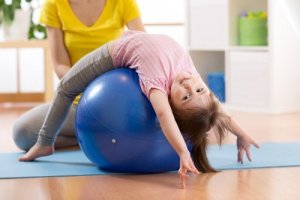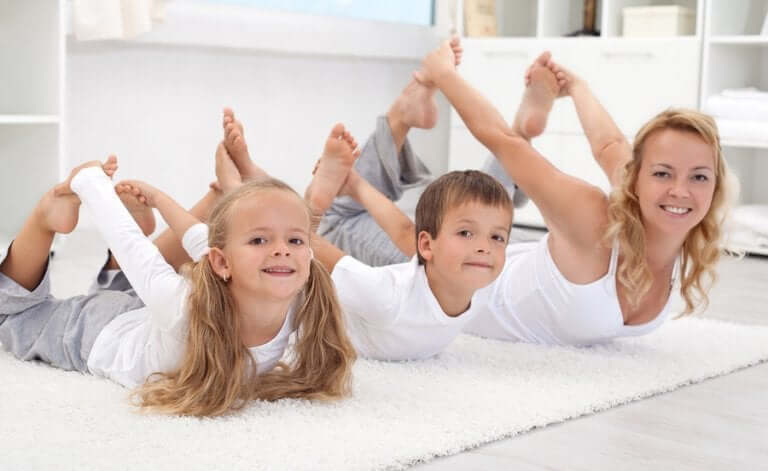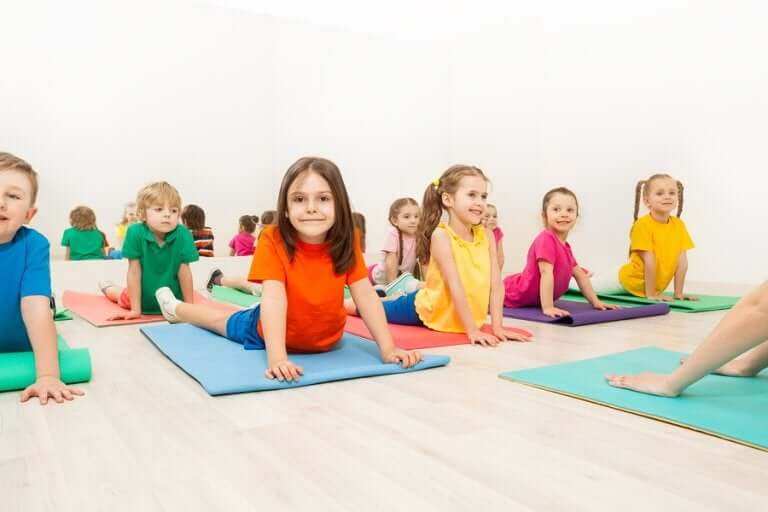The Benefits of Pilates for Children

The benefits of Pilates for children have been analyzed by several specialists in the areas of health and fitness. They’ve concluded that this method of training provides children with a great amount of well-being that their bodies need.
Pilates as a training discipline is very suitable for children and adults alike. Its creator, Joseph Hubertus Pilates, developed it in the early twentieth century, inspired by the ailments he suffered as a child. These led him to explore alternative solutions for muscle strengthening, stimulating elasticity, and relaxation.
If you want to know more about the benefits of Pilates for children, then read on and discover them!
How Pilates works
The Pilates method, created in the early 20th century, is a physical therapy and training technique that aims to strengthen the internal muscles and the development of balance. In this way, it works on every single area of the body.
There are different ways to use this method. Currently, many people mix it with yoga, traditional Chinese medicine postures, gym equipment, and balancing exercises.
However, to carry out a truly traditional Pilates session, then you should take its main principles into account.
Principles of Pilates
The principles of Pilates are the following:
- Alignment of the spine and limbs
- Promoting concentration and the ability to control your mind, in order to be fully aware of each movement that is being carried out.
- Controlling our muscles
- Ensuring a proper management of breathing.

Benefits of Pilates for children
Pilates as a method of physical training can be practiced after reaching seven or eight years of age. A child should begin by performing the simplest exercises, which will consist of stretching poses and muscle control, with poses that aim to improve balance.
The degree of difficulty should be increased gradually, always with the help of a specialized instructor. The positive thing is that, in general, practicing Pilates doesn’t usually have any negative side effects.
The benefits of Pilates for children are mainly focused on strengthening the back, but they can also help improve balance and muscle resistance all over the body.
The fact that it focuses on a child’s back is very important, because that is where children often suffer because of having to carry their backpacks to school on a daily basis. They also tend to have very poor posture when sitting.
Here are some of the many benefits of Pilates for children:
- Decreases levels of stress or hyperactivity in children
- Develops coordination, and helps to promote balance
- Tones the body
- Corrects bad posture
- Burns calories and reduces body fat
- Improves self-confidence and self-esteem
- Increases attention span
- Improves breathing
The Pilates method, created at the beginning of the 20th century, is a physical therapy and training technique that aims to strengthen the internal muscles and develop balance.
Most recommended positions in Pilates for children
Children should do Pilates at least twice a week, in sessions of 30 to 45 minutes, taking into account each child’s age. You should start with simple exercises, ones that are similar to yoga relaxation postures.
The exercises will become more and more complex as the child gets used to them. The child must be aware of the fact that concentration, breathing and balance are the most important factors to carry out these exercises correctly.
Many parents also seek to start their children off with Pilates by teaching them yoga positions.

As with yoga, there are positions in Pilates that have specific names, and the best ones for children are the following:
- Hundred: Improves posture and tones the abdomen
- Swan Pose: Strengthens the chest, back, and spine
- Back and buttock lift: Improves mobility in the spine and firms the buttocks and femur
- Pushups for arms: As the name implies, they tone the arms in connection with the back and spine
To conclude, we’d like to recommend that you carry out this interesting method together with your little one. In addition to receiving all its benefits, you’ll strengthen the bond with your child as you exercise together.
The benefits of Pilates for children have been analyzed by several specialists in the areas of health and fitness. They’ve concluded that this method of training provides children with a great amount of well-being that their bodies need.
Pilates as a training discipline is very suitable for children and adults alike. Its creator, Joseph Hubertus Pilates, developed it in the early twentieth century, inspired by the ailments he suffered as a child. These led him to explore alternative solutions for muscle strengthening, stimulating elasticity, and relaxation.
If you want to know more about the benefits of Pilates for children, then read on and discover them!
How Pilates works
The Pilates method, created in the early 20th century, is a physical therapy and training technique that aims to strengthen the internal muscles and the development of balance. In this way, it works on every single area of the body.
There are different ways to use this method. Currently, many people mix it with yoga, traditional Chinese medicine postures, gym equipment, and balancing exercises.
However, to carry out a truly traditional Pilates session, then you should take its main principles into account.
Principles of Pilates
The principles of Pilates are the following:
- Alignment of the spine and limbs
- Promoting concentration and the ability to control your mind, in order to be fully aware of each movement that is being carried out.
- Controlling our muscles
- Ensuring a proper management of breathing.

Benefits of Pilates for children
Pilates as a method of physical training can be practiced after reaching seven or eight years of age. A child should begin by performing the simplest exercises, which will consist of stretching poses and muscle control, with poses that aim to improve balance.
The degree of difficulty should be increased gradually, always with the help of a specialized instructor. The positive thing is that, in general, practicing Pilates doesn’t usually have any negative side effects.
The benefits of Pilates for children are mainly focused on strengthening the back, but they can also help improve balance and muscle resistance all over the body.
The fact that it focuses on a child’s back is very important, because that is where children often suffer because of having to carry their backpacks to school on a daily basis. They also tend to have very poor posture when sitting.
Here are some of the many benefits of Pilates for children:
- Decreases levels of stress or hyperactivity in children
- Develops coordination, and helps to promote balance
- Tones the body
- Corrects bad posture
- Burns calories and reduces body fat
- Improves self-confidence and self-esteem
- Increases attention span
- Improves breathing
The Pilates method, created at the beginning of the 20th century, is a physical therapy and training technique that aims to strengthen the internal muscles and develop balance.
Most recommended positions in Pilates for children
Children should do Pilates at least twice a week, in sessions of 30 to 45 minutes, taking into account each child’s age. You should start with simple exercises, ones that are similar to yoga relaxation postures.
The exercises will become more and more complex as the child gets used to them. The child must be aware of the fact that concentration, breathing and balance are the most important factors to carry out these exercises correctly.
Many parents also seek to start their children off with Pilates by teaching them yoga positions.

As with yoga, there are positions in Pilates that have specific names, and the best ones for children are the following:
- Hundred: Improves posture and tones the abdomen
- Swan Pose: Strengthens the chest, back, and spine
- Back and buttock lift: Improves mobility in the spine and firms the buttocks and femur
- Pushups for arms: As the name implies, they tone the arms in connection with the back and spine
To conclude, we’d like to recommend that you carry out this interesting method together with your little one. In addition to receiving all its benefits, you’ll strengthen the bond with your child as you exercise together.
All cited sources were thoroughly reviewed by our team to ensure their quality, reliability, currency, and validity. The bibliography of this article was considered reliable and of academic or scientific accuracy.
- Boix Vilella, S., León Zarceño, E., & Serrano Rosa, M. Á. (2014). ¿ Hay beneficios psicosociales por la práctica Pilates?: un análisis de la literatura científica. Cuadernos de Psicología del Deporte, 14(3), 117-128. http://scielo.isciii.es/scielo.php?pid=S1578-84232014000300013&script=sci_arttext&tlng=en
- Andrés Alcoceba, R. (2017). Estudio del método Pilates como tratamiento de la Escoliosis Idiopática en población infantil. Revisión narrativa. https://uvadoc.uva.es/handle/10324/26693
- Carrión, R. P. “Ejercicio terapéutico y pilates en pediatría” Carolina Poncela nos aconseja cómo practicarlo. https://rociopalomocarrion.com/2020/05/08/ejercicio-terapeutico-y-pilates-en-pediatria-carolina-poncela-nos-aconseja-como-practicarlo/
- Loaiza, M., & Rodríguez, M. (2019). el fitness va a la escuela método pilates orientado al desarrollo psicomotor de niños preescolares. Red de Investigación Educativa, 11(2), 89-100. https://revistas.uclave.org/index.php/redine/article/download/2253/1274
This text is provided for informational purposes only and does not replace consultation with a professional. If in doubt, consult your specialist.








